The document provides a comprehensive overview of Linux operating systems, including their history, components, and benefits. It discusses the characteristics of open source software, the significance of the GPL license, and contrasts open source with freeware. Additionally, basic shell commands, their usage, and the functionality of the command line interface (CLI) are elaborated upon to facilitate user interaction with Linux systems.


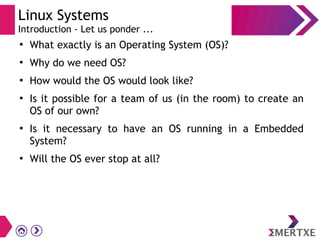











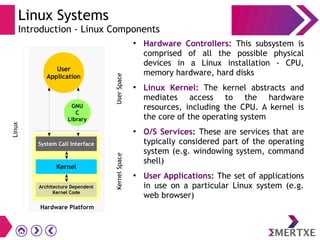


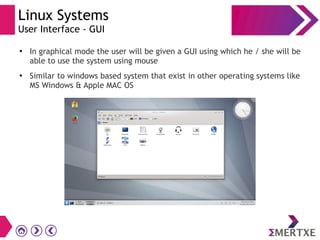
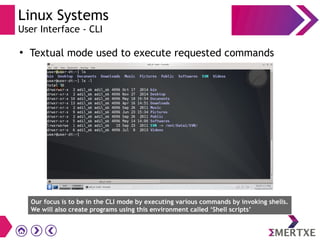
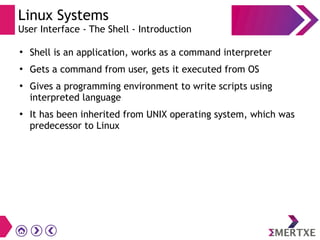
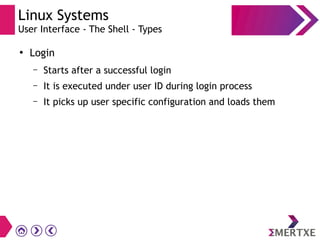

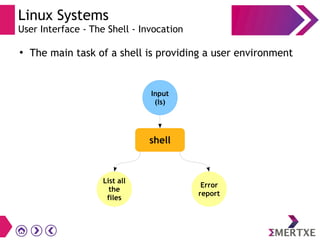

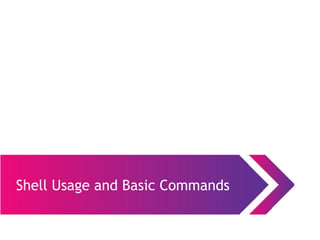
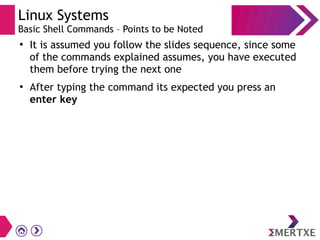
![Linux Systems
Basic Shell Commands - pwd
user@user:~] pwd
/home/user
user@user:~]
●
As soon as we open an terminal we are taken to the users
home directory
●
This can be known with the pwd command
●
Basically, the pwd command tells you about current
working directory](https://image.slidesharecdn.com/linuxsystems1-190430101433/85/Linux-Systems-Getting-started-with-setting-up-an-Embedded-platform-27-320.jpg)
![Linux Systems
Basic Shell Commands - ls
user@user:~] ls
Desktop Downloads Pictures Templates Videos hello.c
Documents Music Public Test1 bin test2
user@user:~]
●
Well, we come to know where we are, how do we know
what do we have there?
●
The list command ls helps us here. The ls display the
contents of the current directory.
●
Well one question should pop up about the category of
these files?
●
From the above image, can tell which is a directory, file
etc..?](https://image.slidesharecdn.com/linuxsystems1-190430101433/85/Linux-Systems-Getting-started-with-setting-up-an-Embedded-platform-28-320.jpg)
![Linux Systems
Basic Shell Commands - man
user@user:~] man ls
●
So how do we come to know about different listing
options?
●
You may use man command, which stands for manual
●
The most useful command which acts as reference
manual if you work in Linux system
●
Almost all the installed applications, libraries and all
would have its own manual entry
●
Even man has its own man page!
user@user:~] man man
●
This helps us to know how read man pages and different
sections in it](https://image.slidesharecdn.com/linuxsystems1-190430101433/85/Linux-Systems-Getting-started-with-setting-up-an-Embedded-platform-29-320.jpg)
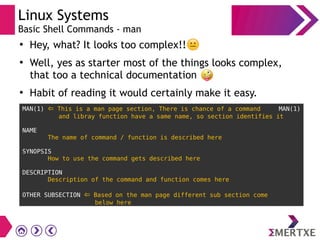
![Linux Systems
Basic Shell Commands - man
●
So from man page of ls we get the following option
●
Where
user@user:~] ls -F
Desktop/ Downloads/ Pictures/ Templates/ Videos/ hello.c
Documents/ Music/ Public/ Test1/ bin/ test2@
user@user:~]
/ Directory→
@ Symbolic Link→
* Executable→
| Pipe→
and more](https://image.slidesharecdn.com/linuxsystems1-190430101433/85/Linux-Systems-Getting-started-with-setting-up-an-Embedded-platform-31-320.jpg)
![Linux Systems
Basic Shell Commands – Anatomy of a Command
user@user:~] command_name [arguments]
●
A command may have multiple arguments
●
Arguments could be options to the command, file paths or arguments itself
options starts with – which is called as short options which has single letter or –– called as
long options with a word
●
Some of the arguments are optional which is mentioned within [ ]
●
The below example shows the contents of Documents directory with color option enabled
user@user:~] ls -l --color Documents/
●
A command which gets interpreted by shell
●
Could be a super user command which gets executed with sudo
●
The below is an example shows how to install a package in Ubuntu
user@user:~] sudo apt install vim
[arguments]
command_name
user@user:~]
●
Command prompt, which could be customized
●
Default prompt after installation would look like as shown below
user@user:~$](https://image.slidesharecdn.com/linuxsystems1-190430101433/85/Linux-Systems-Getting-started-with-setting-up-an-Embedded-platform-32-320.jpg)

![Linux Systems
Basic Shell Commands – Types of commands
●
To know the type of a command, you may try the
following
user@user:~] type <command_name>
user@user:~] type ls
ls is aliased to `ls -v --color=auto'
user@user:~] type pwd
pwd is a shell builtin
user@user:~] type clear
clear is /usr/bin/clear
user@user:~]
●
Few examples](https://image.slidesharecdn.com/linuxsystems1-190430101433/85/Linux-Systems-Getting-started-with-setting-up-an-Embedded-platform-34-320.jpg)
![Linux Systems
Basic Shell Commands - cd
user@user:~] ls
Desktop Documents Downloads Music Pictures Public Templates Videos
user@user:~] cd Documents/
user@user:Documents]
●
cd to change directory. A shell built-in command
●
The above example changes the directory to Documents
●
Now how to go back?!
●
We need to understand the concept of the path, which is
explained in the next slide](https://image.slidesharecdn.com/linuxsystems1-190430101433/85/Linux-Systems-Getting-started-with-setting-up-an-Embedded-platform-35-320.jpg)
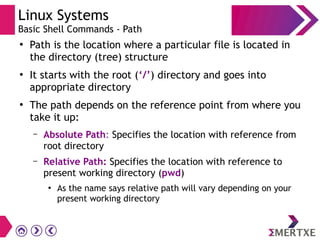
![Linux Systems
Basic Shell Commands - Path
tmp
sys
usr
var
dev
home
media
proc
sbin
boot
etc
lib
mnt
root
bin
/
Downloads
Pictures
Templates
Documents
Music
Public
Videos
Desktop
user@user:~] ls
Desktop Documents Downloads Music Pictures
Public Templates Videos
user@user:~]
user](https://image.slidesharecdn.com/linuxsystems1-190430101433/85/Linux-Systems-Getting-started-with-setting-up-an-Embedded-platform-37-320.jpg)
![Linux Systems
Basic Shell Commands - Path - Relative
tmp
sys
usr
var
dev
home
media
proc
sbin
boot
etc
lib
mnt
root
bin
/
Downloads
Pictures
Templates
Documents
Music
Public
Videos
Desktop
user
user@user:~] ls
Desktop Documents Downloads Music Pictures
Public Templates Videos
user@user:~] cd Documents/
user@user:Documents]](https://image.slidesharecdn.com/linuxsystems1-190430101433/85/Linux-Systems-Getting-started-with-setting-up-an-Embedded-platform-38-320.jpg)
![Linux Systems
Basic Shell Commands - Path - Relative
tmp
sys
usr
var
dev
home
media
proc
sbin
boot
etc
lib
mnt
root
bin
/ user@user:~] ls
Desktop Documents Downloads Music Pictures
Public Templates Videos
user@user:Documents] cd ..
user@user:~]
Downloads
Pictures
Templates
Music
Public
Videos
Desktop
Documents
user](https://image.slidesharecdn.com/linuxsystems1-190430101433/85/Linux-Systems-Getting-started-with-setting-up-an-Embedded-platform-39-320.jpg)
![Linux Systems
Basic Shell Commands - Path - Absoulte
tmp
sys
usr
var
dev
home
media
proc
sbin
boot
etc
lib
mnt
root
bin
/
Downloads
Pictures
Templates
Documents
Music
Public
Videos
Desktop
user
user@user:~] ls
Desktop Documents Downloads Music Pictures
Public Templates Videos
user@user:Documents] cd /home/user/
user@user:~]](https://image.slidesharecdn.com/linuxsystems1-190430101433/85/Linux-Systems-Getting-started-with-setting-up-an-Embedded-platform-40-320.jpg)
![Linux Systems
Basic Shell Commands - mkdir
user@user:~] ls
Desktop Documents Downloads Music Pictures Public Templates Videos
user@user:~] mkdir TBD # TBD - ToBeDeleted
user@user:~] ls
Desktop Documents Downloads Music Pictures Public Templates TBD
Videos
user@user:~]
●
mkdir to create directories
●
Creates the directory(ies), if they do not already exists
user@user:~] ls
Desktop Documents Downloads Music Pictures Public Templates TBD
Videos
user@user:~] mkdir TBD
mkdir: cannot create directory ‘TBD’: File exists
user@user:~]
●
Well, # represents start of comment in shell, anything
written after that would be seen as comment!](https://image.slidesharecdn.com/linuxsystems1-190430101433/85/Linux-Systems-Getting-started-with-setting-up-an-Embedded-platform-41-320.jpg)
![Linux Systems
Basic Shell Commands - rmdir
user@user:~] ls
Desktop Documents Downloads Music Pictures Public Templates TBD
Videos
user@user:~] rmdir TBD
user@user:~] ls
Desktop Documents Downloads Music Pictures Public Templates Videos
user@user:~]
●
rmdir to remove empty directories
●
Removes the directory(ies), if they are empty
user@user:~] mkdir TBD # TBD - ToBeDeleted
user@user:~] ls
Desktop Documents Downloads Music Pictures Public Templates TBD
Videos
user@user:~] cd TBD
user@user:TBD] mkdir Test
user@user:TBD] cd ..
user@user:~] rmdir TBD
rmdir: failed to remove 'TBD': Directory not empty
user@user:~]](https://image.slidesharecdn.com/linuxsystems1-190430101433/85/Linux-Systems-Getting-started-with-setting-up-an-Embedded-platform-42-320.jpg)
![Linux Systems
Basic Shell Commands - rm
●
The previous slide leads to a question on how to delete a
non empty directory?
●
rm to remove files or directories
●
Removes each specified file. By default, it does not
remove directories.
user@user:~] ls
Desktop Documents Downloads Music Pictures Public Templates TBD
Videos
user@user:~] ls TBD
Test
user@user:~] rm TBD
rm: cannot remove 'TBD/': Is a directory
user@user:~]
●
Then how??, Well we need to refer the man pages](https://image.slidesharecdn.com/linuxsystems1-190430101433/85/Linux-Systems-Getting-started-with-setting-up-an-Embedded-platform-43-320.jpg)
![Linux Systems
Basic Shell Commands - rm
●
From the man page or rm you find a option -r which
stands for recursive
user@user:~] rm -r TBD
user@user:~] ls
Desktop Documents Downloads Music Pictures Public Templates Videos
user@user:~]
●
Note, once deleted, you loose the files permanently!, its
equivalent to Shift + Delete
●
Now what if you delete a file or a folder mistakenly?
Wouldn’t you like that the shell ask you before you
delete? So that you avoid these types of issues!
●
Well will see it in the next slide](https://image.slidesharecdn.com/linuxsystems1-190430101433/85/Linux-Systems-Getting-started-with-setting-up-an-Embedded-platform-44-320.jpg)
![Linux Systems
Basic Shell Commands - rm
●
The -i option provides interactivity
●
Did you observe from the above screen shot that the shell
prompts before you take any action!, you may say y or n
●
There is always a second chance
●
But what if you forget -i?
user@user:~] mkdir TBD # TBD - ToBeDeleted
user@user:~] ls
Desktop Documents Downloads Music Pictures Public Templates TBD
Videos
user@user:~] cd TBD
user@user:TBD] mkdir Test
user@user:TBD] cd ..
user@user:~] rm -ri TBD
rm: descend into directory 'TBD/'? y
rm: remove directory 'TBD/Test'? y
rm: remove directory 'TBD/'? y
user@user:~]](https://image.slidesharecdn.com/linuxsystems1-190430101433/85/Linux-Systems-Getting-started-with-setting-up-an-Embedded-platform-45-320.jpg)
![Linux Systems
Basic Shell Commands - alias
●
The solution the question in the previous slide is alias
●
An builtin bash command, which helps us to name an
operation (command), literally anything
●
Some built aliases are as shown below
user@user:~] alias
alias egrep='egrep --color=auto'
alias fgrep='fgrep --color=auto'
alias grep='grep --color=auto'
alias l='ls -CF'
alias la='ls -A'
alias ll='ls -l'
alias ls='ls --color=auto'
user@user:~]
●
List varies based on your system installation
●
Well how do we create one? How does it solve our issue?](https://image.slidesharecdn.com/linuxsystems1-190430101433/85/Linux-Systems-Getting-started-with-setting-up-an-Embedded-platform-46-320.jpg)
![Linux Systems
Basic Shell Commands - alias
●
We may create our own alias with required options as
shown below
user@user:~] alias rm=’rm -i’
user@user:~] alias
alias egrep='egrep --color=auto'
alias fgrep='fgrep --color=auto'
alias grep='grep --color=auto'
alias l='ls -CF'
alias la='ls -A'
alias ll='ls -l'
alias ls='ls –color=auto'
alias rm=’rm -i’
user@user:~]
●
Note our alias at the end
●
A new command (operation) named rm is created, when
used henceforth will be rm -i](https://image.slidesharecdn.com/linuxsystems1-190430101433/85/Linux-Systems-Getting-started-with-setting-up-an-Embedded-platform-47-320.jpg)
![Linux Systems
Basic Shell Commands - alias
●
Lets repeat all the steps again to test our new command
●
Observe that, this time we didn’t provide the -i option!
●
How does it work?, its the because of our alias we
created.
●
The name of new command can be anything, but let it be
meaningful
user@user:~] mkdir TBD # TBD - ToBeDeleted
user@user:~] ls
Desktop Documents Downloads Music Pictures Public Templates TBD
Videos
user@user:~] cd TBD
user@user:TBD] mkdir Test
user@user:TBD] cd ..
user@user:~] rm -r TBD
rm: descend into directory 'TBD/'? y
rm: remove directory 'TBD/Test'? y
rm: remove directory 'TBD/'? y
user@user:~]](https://image.slidesharecdn.com/linuxsystems1-190430101433/85/Linux-Systems-Getting-started-with-setting-up-an-Embedded-platform-48-320.jpg)

![Linux Systems
Basic Shell Commands – Bash Files
●
Hidden files used by the login as well as non-login shells
●
Found in users home directory
user@user:~] pwd
/home/user
user@user:~] ls -a
. .bash_logout .cache Documents Pictures Templates
.. .bash_profile .config Downloads .profile Videos
.bash_history .bashrc Desktop Music Public .vimrc
user@user:~]
●
These are some configuration files which gets sourced to
bash on every new instance is created](https://image.slidesharecdn.com/linuxsystems1-190430101433/85/Linux-Systems-Getting-started-with-setting-up-an-Embedded-platform-50-320.jpg)




![Linux Systems
Basic Shell Commands - touch
●
An command which helps us to update the timestamp of
the existing files
●
If the file argument that does not exist is created empty
user@user:~] mkdir TBD # TBD - ToBeDeleted
user@user:~] cd TBD
user@user:TBD] ls
user@user:TBD] touch file1 file2 file3
user@user:TBD] ls
file1 file2 file3
user@user:TBD]
●
Observe that the directory was empty, using touch command it
created the mentioned files
●
As mentioned it is generally used to update the time stamp, so
you wonder what would be the use of it?
●
Well, they are used by some advanced commands like make](https://image.slidesharecdn.com/linuxsystems1-190430101433/85/Linux-Systems-Getting-started-with-setting-up-an-Embedded-platform-55-320.jpg)
![Linux Systems
Basic Shell Commands - touch
●
The scope of this topic is to create some empty files
which will help learning some of the commands we are
going cover next slides
●
But lets see the behavior of the command a bit
user@user:TBD] ls -l
total 0
-rw-rw-r-- 1 user user 0 Nov 30 22:18 file1
-rw-rw-r-- 1 user user 0 Nov 30 22:18 file2
-rw-rw-r-- 1 user user 0 Nov 30 22:18 file3
user@user:TBD]
●
Note the creation time of all the files
user@user:TBD] touch file1 file2 file3 # 20 Seconds after creation!
user@user:TBD] ls -l
total 0
-rw-rw-r-- 1 user user 0 Nov 30 22:38 file1
-rw-rw-r-- 1 user user 0 Nov 30 22:38 file2
-rw-rw-r-- 1 user user 0 Nov 30 22:38 file3
user@user:TBD]](https://image.slidesharecdn.com/linuxsystems1-190430101433/85/Linux-Systems-Getting-started-with-setting-up-an-Embedded-platform-56-320.jpg)
![Linux Systems
Basic Shell Commands - cp
●
cp to copy files and directory
●
Accepts to 2 arguments as the source and destiny
user@user:TBD] cp <source> <destiny>
●
The source and destiny are the path of files to be copied
from and to
user@user:TBD] ls
file1 file2 file3
user@user:TBD] cp file1 file4
user@user:TBD] ls
file1 file2 file3 file4
user@user:TBD] cp file1 ../file5
user@user:TBD] ls ../
Desktop Documents Downloads file5 Music Pictures Public Templates
TBD Videos
user@user:TBD] cp ../file5 .
user@user:TBD] ls
file1 file2 file3 file4 file5
user@user:TBD]](https://image.slidesharecdn.com/linuxsystems1-190430101433/85/Linux-Systems-Getting-started-with-setting-up-an-Embedded-platform-57-320.jpg)
![Linux Systems
Basic Shell Commands - cp
●
While copying the directory the -r option has to be used
user@user:TBD] mkdir Test
user@user:TBD] ls
file1 file2 file3 file4 file5 Test
user@user:TBD] cp Test/ TestCopy
cp: -r not specified; omitting directory 'Test/'
user@user:TBD] cp -r Test/ TestCopy
user@user:TBD] ls
file1 file2 file3 file4 file5 Test TestCopy
user@user:TBD] cp file1 file2 file3 Test
user@user:TBD] ls Test/
file1 file2 file3
user@user:TBD]](https://image.slidesharecdn.com/linuxsystems1-190430101433/85/Linux-Systems-Getting-started-with-setting-up-an-Embedded-platform-58-320.jpg)
![Linux Systems
Basic Shell Commands - mv
●
mv to move of rename files and directories
●
Accepts to 2 arguments as the source and destiny
user@user:TBD] mv <source> <destiny>
●
The source and destiny are the path of files to be moved
or renamed from and to
user@user:TBD] ls ../
Desktop Documents Downloads file5 Music Pictures Public Templates
TBD Videos
user@user:TBD] mv ../file5 TestCopy
user@user:TBD] ls TestCopy
file5
user@user:TBD] ls ../
Desktop Documents Downloads Music Pictures Public Templates TBD
Videos
user@user:TBD]
●
Note the above context, the file gets moved](https://image.slidesharecdn.com/linuxsystems1-190430101433/85/Linux-Systems-Getting-started-with-setting-up-an-Embedded-platform-59-320.jpg)
![Linux Systems
Basic Shell Commands - mv
user@user:TBD] ls
file1 file2 file3 file4 file5 Test TestCopy
user@user:TBD] mv file1 file1.txt
user@user:TBD] ls
file1.txt file2 file3 file4 file5 Test TestCopy
user@user:TBD]
●
In this context, the file gets renamed](https://image.slidesharecdn.com/linuxsystems1-190430101433/85/Linux-Systems-Getting-started-with-setting-up-an-Embedded-platform-60-320.jpg)

![Linux Systems
Visual Editor - vi
●
Screen-oriented text editor originally created for the
Unix operating system
●
The name vi is derived from the shortest unambiguous
abbreviation for the ex command visual
●
Improved version is called as vim
●
To open a file
user@user:TBD] vi <file_name>
user@user:TBD] vim <file_name>
or](https://image.slidesharecdn.com/linuxsystems1-190430101433/85/Linux-Systems-Getting-started-with-setting-up-an-Embedded-platform-62-320.jpg)
![Linux Systems
Visual Editor - vim
Mode Functions Key
Escape Search
File Edit
Esc
Edit Insert
Replace
i / I
r / R
Visual Selection v / V
Command Line Commands :
●
vi opens a file in command mode to start mode.
●
The power of vi comes from the following modes
●
To get a basic grip on vi you may type vimtutor on the
terminal. Just read and follow the instructions
user@user:TBD] vimtutor](https://image.slidesharecdn.com/linuxsystems1-190430101433/85/Linux-Systems-Getting-started-with-setting-up-an-Embedded-platform-63-320.jpg)
![Linux Systems
Visual Editor – vim - Information
user@user:TBD] ls
file1.txt file2 file3 file4 file5 Test TestCopy
user@user:TBD] vi file.txt
█
~
~
~
~
~
~
~
~
~
"file.txt" [New File] 0,0-1 All
filename,
mode,
previous action
command prompt
line, cursor view %file
command
information](https://image.slidesharecdn.com/linuxsystems1-190430101433/85/Linux-Systems-Getting-started-with-setting-up-an-Embedded-platform-64-320.jpg)
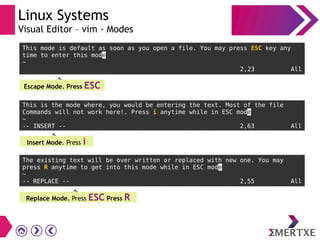


![Linux Systems
Visual Editor – vi – Insert
~
"test.txt" [New File] 0,0-1 All
Press i
user@user:TBD] vi test.txt
~
~
-- INSERT -- 0,1 All
Start typing something
Hey all!, let do some vimming :)
~
-- INSERT -- 0,33 All
Press ESC](https://image.slidesharecdn.com/linuxsystems1-190430101433/85/Linux-Systems-Getting-started-with-setting-up-an-Embedded-platform-68-320.jpg)
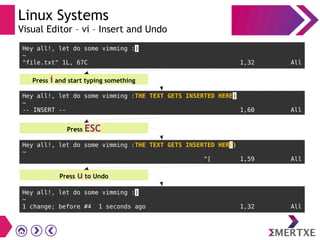

![Linux Systems
Visual Editor – vi – Write and Quit
Hey all!, let do some vimming :)
~
~
~
:w
To save. Press w and ENTER
Hey all!, let do some vimming :)
~
~
~
:"test.txt" 1L, 57C [w] 1,56 All
Hey all!, let do some vimming :)
~
~
~
:q
To quit. Press q and ENTER](https://image.slidesharecdn.com/linuxsystems1-190430101433/85/Linux-Systems-Getting-started-with-setting-up-an-Embedded-platform-71-320.jpg)
![Linux Systems
Visual Editor – vi – Write and Quit
user@user:TBD] ls
file1.txt file2 file3 file4 file5 Test TestCopy
user@user:TBD] vi test.txt
user@user:TBD] ls
file1.txt file2 file3 file4 file5 Test TestCopy test.txt
user@user:TBD]
●
Just to understand this better, lets learn the cat
command before we proceed further](https://image.slidesharecdn.com/linuxsystems1-190430101433/85/Linux-Systems-Getting-started-with-setting-up-an-Embedded-platform-72-320.jpg)
![Linux Systems
vi - Basic Shell Commands - cat
user@user:TBD] ls
file1.txt file2 file3 file4 file5 Test TestCopy
user@user:TBD] vi test.txt
user@user:TBD] ls
file1.txt file2 file3 file4 file5 Test TestCopy test.txt
user@user:TBD] cat test.txt
Hey all!, let do some vimming :)
user@user:TBD]
●
Displays the contents of the file on the screen
●
cat has many advanced functionalities which will be
covered later as required
●
cat to concatenate files and print on standard output](https://image.slidesharecdn.com/linuxsystems1-190430101433/85/Linux-Systems-Getting-started-with-setting-up-an-Embedded-platform-73-320.jpg)
![Linux Systems
Visual Editor – vi – Write and Quit
Hey all!, let do some vimming :)
~
~
~
:wq
To save and quit. Press wq and ENTER
user@user:TBD] vi test.txt
Hey all!, let do some vimming :)
Added this line too!! which will be missing!
~
~
:q!
To quit without saving. Press q! and ENTER
user@user:TBD] vi test.txt](https://image.slidesharecdn.com/linuxsystems1-190430101433/85/Linux-Systems-Getting-started-with-setting-up-an-Embedded-platform-74-320.jpg)


![Linux Systems
Visual Editor – vi – Yank (Copy) and Paste
Hey all!, let do some vimming :)
~
1 change; before #4 1 seconds ago y 1,1 All
Press ESC and yy and start typing something Press p
Hey all!, let do some vimming :)
Hey all!, let do some vimming :)
~
~
1 change; before #4 1 seconds ago 2,1 All
●
You may copy multiple lines and paste times using the
following syntax
– [n]yy – Copy n line(s) Say n = 10, 10yy copies 10 lines→
– [n]p – Paste copied line(s) n time Say n = 10, 10p→
pastes the copied line(s) 10 times
●
Note, this rule applies to almost all the commands](https://image.slidesharecdn.com/linuxsystems1-190430101433/85/Linux-Systems-Getting-started-with-setting-up-an-Embedded-platform-77-320.jpg)



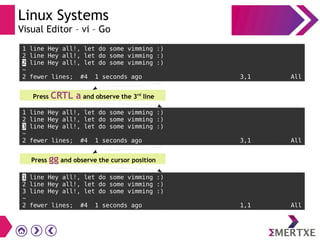
![Linux Systems
Visual Editor – vi – Go
●
The most useful shortcut to navigate between different
lines
– [n]gg – Go to nth line Say n = 10, 10gg takes you to 10→
line
– gg take you the first line of the file
– G take you the last line of the file](https://image.slidesharecdn.com/linuxsystems1-190430101433/85/Linux-Systems-Getting-started-with-setting-up-an-Embedded-platform-82-320.jpg)
![Linux Systems
Visual Editor – vi – Delete
1 line Hey all!, let do some vimming :)
2 line Hey all!, let do some vimming :)
3 line Hey all!, let do some vimming :)
~
2 fewer lines; #4 1 seconds ago 1,1 All
Press 2dd and observe
3 line Hey all!, let do some vimming :)
~
~
~
2 fewer lines; #4 1 seconds ago 1,1 All
●
You may delete multiple lines from the current cursor
position
– [n]dd – Delete n line(s) Say n = 10, 10dd delete 10 lines→
– D the current line from the cursor position](https://image.slidesharecdn.com/linuxsystems1-190430101433/85/Linux-Systems-Getting-started-with-setting-up-an-Embedded-platform-83-320.jpg)
![Linux Systems
Visual Editor – vi – Decrement
Press 2 CTRL x and observe
1 line Hey all!, let do some vimming :)
~
~
~
2 fewer lines; #4 1 seconds ago 1,1 All
●
You may increment and decrement n times
– [n]CTRL x – Increments the first integer match from the
cursor position Say n = 10 and number is 13,→
10 CTRL x decrements the number by 10,
resulting to number 3
– The increments works the same way](https://image.slidesharecdn.com/linuxsystems1-190430101433/85/Linux-Systems-Getting-started-with-setting-up-an-Embedded-platform-84-320.jpg)
![Linux Systems
Visual Editor – vi – Navigation - Forward
Press w and observe cursor1 line Hey all!, let do some vimming :)
~
~
~
1,1 All
1 line Hey all!, let do some vimming :)
~
~
~
1,8 All
Press w and observe cursor
1 line Hey all!, let do some vimming :)
~
~
~
1,18 All
Press 3w and observe cursor
●
[n]w – Move forward n words Say n = 10w – move 10 words→
ahead](https://image.slidesharecdn.com/linuxsystems1-190430101433/85/Linux-Systems-Getting-started-with-setting-up-an-Embedded-platform-85-320.jpg)
![Linux Systems
Visual Editor – vi – Navigation - Backward
Press b and observe cursor1 line Hey all!, let do some vimming :)
~
~
~
1,18 All
1 line Hey all!, let do some vimming :)
~
~
~
1,15 All
Press b and observe cursor
1 line Hey all!, let do some vimming :)
~
~
~
1,18 All
Press 2b and observe cursor
●
[n]b – Move backward n words Say n = 10b – move 10→
words behind](https://image.slidesharecdn.com/linuxsystems1-190430101433/85/Linux-Systems-Getting-started-with-setting-up-an-Embedded-platform-86-320.jpg)
![Linux Systems
Visual Editor – vi – Change Word
1 line Hey all!, let do some vimming :)
~
~
~
1,18 All
Press cw and observe
●
[n]cw – Change n words Say n = 10cw – change 10 words→
from the current cursor position
1 line all!, let do some vimming :)
~
~
~
-- INSERT -- 1,8 All
You may insert the new words](https://image.slidesharecdn.com/linuxsystems1-190430101433/85/Linux-Systems-Getting-started-with-setting-up-an-Embedded-platform-87-320.jpg)
![Linux Systems
Visual Editor – vi – Delete Word
1 line Hey all!, let do some vimming :)
~
~
~
1 change; before #16 1,18 All
Press u to Undo
●
[n]dw – Delete n words Say n = 10dw – delete 10 words→
from the current cursor position
1 line all!, let do some vimming :)
~
~
~
1,8 All
Press dw and observe](https://image.slidesharecdn.com/linuxsystems1-190430101433/85/Linux-Systems-Getting-started-with-setting-up-an-Embedded-platform-88-320.jpg)

![Linux Systems
Visual Editor – vi – Search - Forward
●
[n]n – Forward search n words Say n = 10n – Searches the→
10 words from the current position forward
1 line Hey all!, let do some vimming :)
~
~
~
/e 1,6 All
Press / and type search pattern
and ENTER
1 line Hey all!, let do some vimming :)
~
~
~
/e 1,9 All
Press n](https://image.slidesharecdn.com/linuxsystems1-190430101433/85/Linux-Systems-Getting-started-with-setting-up-an-Embedded-platform-90-320.jpg)
![Linux Systems
Visual Editor – vi – Search - Backward
●
[n]n – Reverse search n words Say n = 10n – Searches the→
10 words from the current position backwards
1 line Hey all!, let do some vimming :)
~
~
~
/e 1,9 All
Press N
1 line Hey all!, let do some vimming :)
~
~
~
search hit TOP, continuing at BOTTOM All
Press 3N and observe the
cursor position
1 line Hey all!, let do some vimming :)
~
~
~
:set nohls
Type :set nohls and ENTER
to disable search highlights](https://image.slidesharecdn.com/linuxsystems1-190430101433/85/Linux-Systems-Getting-started-with-setting-up-an-Embedded-platform-91-320.jpg)
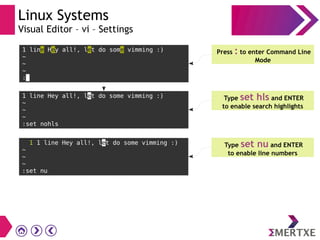

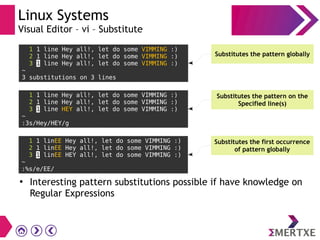
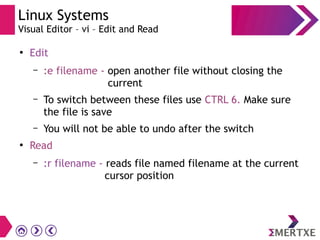
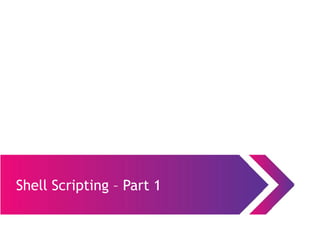

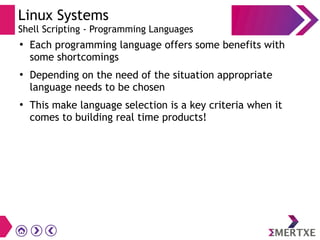



![Linux Systems
Shell Scripting - Script – Example
1 #!/bin/bash
2 echo "Hello World" # Print Hello World on standard output
~
~
:wq
user@user:Classwork] vi hello.sh
user@user:~] cd # Move to home directory
user@user:~] mkdir -p ECEP/LinuxSystems/Classwork
user@user:~] cd ECEP/LinuxSystems/Classwork
user@user:Classwork]
user@user:Classwork] bash hello.sh
Hello World
user@user:Classwork] ls -l
-rw-rw-r-- 1 adil adil 31 Dec 2 21:44 hello.sh
user@user:Classwork] chmod +x hello.sh
user@user:Classwork] ls -l
-rwxrwxr-x 1 adil adil 31 Dec 2 21:44 hello.sh
user@user:Classwork] ./hello.sh
Hello World
user@user:Classwork]](https://image.slidesharecdn.com/linuxsystems1-190430101433/85/Linux-Systems-Getting-started-with-setting-up-an-Embedded-platform-102-320.jpg)
![Linux Systems
Shell Scripting - Script – echo
user@user:Classwork] echo Hello World
Hello World
user@user:Classwork]
●
echo displays a line of text
●
Helps use to print on screen with required formatting
●
Used in scripts to print normal messages and the value of
variable, which will be seeing shortly
●
Some examples are as shown below
user@user:Classwork] echo HellonWorld # To print on 2 seperate line
HellonWorld
user@user:Classwork] echo -e “HellonWorld” # To print on 2 seperate line
Hello
World
user@user:Classwork] echo -e “HellotWorld” # To words with tab
Hello World
user@user:Classwork] echo -e “HellorWorld” # To overwrite previous print
World
user@user:Classwork]](https://image.slidesharecdn.com/linuxsystems1-190430101433/85/Linux-Systems-Getting-started-with-setting-up-an-Embedded-platform-103-320.jpg)
![Linux Systems
Shell Scripting - Special Characters
user@user:Classwork] echo ~ # Expands to users home directory path
/home/user
user@user:Classwork]
●
Characters which has special meaning
●
Used in many advanced functionalities
●
Lets understand some of the most important ones
user@user:Classwork] firefox
⇐ Observe here, the shell would be held by the application you invoked!!
~ → The current user's home directory
& Open applications or commands→ in the background
user@user:Classwork] firefox & # firefox is opened in background
[1] 7746
user@user:Classwork] # You may use the command prompt](https://image.slidesharecdn.com/linuxsystems1-190430101433/85/Linux-Systems-Getting-started-with-setting-up-an-Embedded-platform-104-320.jpg)
![Linux Systems
Shell Scripting - Special Characters
user@user:Classwork] mkdir TBD
user@user:TBD] cd TBD
user@user:TBD] touch file_{1..5}.txt # Create 5 files from 1 to 5
user@user:TBD] touch file_{6..10}.c
user@user:TBD] touch file_{1..5}.sh
user@user:TBD] ls
file_10.c file_13.sh file_1.txt file_4.txt file_7.c
file_11.sh file_14.sh file_2.txt file_5.txt file_8.c
file_12.sh file_15.sh file_3.txt file_6.c file_9.c
user@user:TBD] ls *.txt
file_1.txt file_2.txt file_3.txt file_4.txt file_5.txt
user@user:TBD] ls *1*
file_10.c file_12.sh file_14.sh file_1.txt
file_11.sh file_13.sh file_15.sh
user@user:TBD]
* → wildcard, matching zero or more characters (e.g. : ls doc_*)](https://image.slidesharecdn.com/linuxsystems1-190430101433/85/Linux-Systems-Getting-started-with-setting-up-an-Embedded-platform-105-320.jpg)
![Linux Systems
Shell Scripting - Special Characters
user@user:TBD] ls
file_10.c file_13.sh file_1.txt file_4.txt file_7.c
file_11.sh file_14.sh file_2.txt file_5.txt file_8.c
file_12.sh file_15.sh file_3.txt file_6.c file_9.c
user@user:TBD] ls file_?.c
file_6.c file_7.c file_8.c file_9.c
user@user:TBD] ls file_??.c
file_10.c
user@user:TBD] ls file_??.*
file_10.c file_11.sh file_12.sh file_13.sh file_14.sh file_15.sh
user@user:TBD]
? → wildcard, matching exactly one character (e.g.: ls doc_?)](https://image.slidesharecdn.com/linuxsystems1-190430101433/85/Linux-Systems-Getting-started-with-setting-up-an-Embedded-platform-106-320.jpg)
![Linux Systems
Shell Scripting - Special Characters
user@user:TBD] echo $ # Note, A $ with any non space character will be seen
as a variable. Will see this in next few slides
$
user@user:TBD] echo $0 # Expands to name of the shell or shell script
/bin/bash
user@user:TBD] echo $$ # Expands to this shell process id
2668
user@user:TBD] echo $? # Expands to the status of the previous command
0
user@user:TBD]
$ → used to access a variable (e.g. : $HOME), used with echo command
●
There 2 more which makes sense in a script will see them
shortly
– $@ → Value of all arguments passed
– $# → No of arguments passed to shell script](https://image.slidesharecdn.com/linuxsystems1-190430101433/85/Linux-Systems-Getting-started-with-setting-up-an-Embedded-platform-107-320.jpg)
![Linux Systems
Shell Scripting - Variables
●
Variables are a way of storing information temporarily
●
A couple of conversions we need to follow
– Variables usually appear in uppercase
– There should not be a white space between the variable
name and the equal sign
user@user:TBD] X=10
user@user:TBD] echo $X # Any non space charater adjacent to $ is a variable
10
user@user:TBD] NAME=”EMERTXE”
user@user:TBD] echo $NAME
EMERTXE
user@user:TBD] echo $DUMMY # The DUMMY variable is not set. Hence no print
user@user:TBD]](https://image.slidesharecdn.com/linuxsystems1-190430101433/85/Linux-Systems-Getting-started-with-setting-up-an-Embedded-platform-108-320.jpg)
![Linux Systems
Shell Scripting - White-space & Line-breaks
●
Bash shell scripts are very sensitive to white-space & line-
breaks
●
Because the “keywords” of this programming language are
actually commands evaluated by the shell
●
Need to separate arguments with white spaces
●
Likewise a line-break in the middle of a command will mislead
the shell into thinking the command is incomplete.
user@user:TBD] TEST = 10 # Not allowed
TEST: command not found
user@user:TBD] TEST1=10; TEST2=20 # Allowed
user@user:TBD] echo $TEST1 $TEST2
10 20
user@user:TBD]](https://image.slidesharecdn.com/linuxsystems1-190430101433/85/Linux-Systems-Getting-started-with-setting-up-an-Embedded-platform-109-320.jpg)

![Linux Systems
Shell Scripting - The Shell Env Variables
user@user:TBD] echo $HOME # The current user's home directory
/home/user
user@user:TBD] echo $SHELL # Shell that will be interpreting user commands
/bin/bash
user@user:TBD] echo $USER # The current logged in user
user
user@user:TBD] echo $PWD # The previous working directory
/home/user/ECEP/LinuxSystems/Classwork/TBD
user@user:TBD] echo $OLDPWD # The previous working directory
/home/user
user@user:TBD] echo $PATH # System will check when looking for commands here
/usr/local/sbin:/usr/local/bin:/usr/sbin:/usr/bin:/sbin:/bin:/usr/games:/usr/
local/games:/snap/bin:
user@user:TBD] echo $HOSTNAME # The hostname of the computer
emertxe
user@user:TBD] echo $TERM # Type of terminal to emulate when running the shell
xterm-256color
user@user:TBD] echo $PS1
[e]0;u@h: wa]${debian_chroot:+($debian_chroot)}[033[01;32m]u@h[
033[00m]:[033[01;34m]W[033[00m]]
user@user:TBD]](https://image.slidesharecdn.com/linuxsystems1-190430101433/85/Linux-Systems-Getting-started-with-setting-up-an-Embedded-platform-111-320.jpg)
![Linux Systems
Shell Scripting - Quotes
●
Using double quotes to show a string of characters will
allow any variables in the quotes to be resolved
user@user:TBD] VAR=10
user@user:TBD] echo $VAR
10
user@user:TBD] echo “The value is $VAR”
The value is 10
user@user:TBD]
●
Using single quotes causes the variable name to be used
literally, and no substitution will take place
user@user:TBD] VAR=10
user@user:TBD] echo $VAR
10
user@user:TBD] echo ‘The value is $VAR’
The value is $VAR
user@user:TBD]](https://image.slidesharecdn.com/linuxsystems1-190430101433/85/Linux-Systems-Getting-started-with-setting-up-an-Embedded-platform-112-320.jpg)
![Linux Systems
Shell Scripting - Expressions
●
expr Evaluates simple math on the command line
calculator
●
bc An arbitrary precision calculator language
user@user:TBD] expr 10 + 20
30
user@user:TBD] expr 10 * 20
expr: syntax error
user@user:TBD] expr 10 * 20 # * acts a wildcard, so need to escape it
200
user@user:TBD]
user@user:TBD] bc
bc 1.06.95
Copyright 1991-1994, 1997, 1998, 2000, 2004, 2006 Free Software Foundati
on, Inc. This is free software with ABSOLUTELY NO WARRANTY.
For details type `warranty'./
10 * 20
200
10 + 34 * 23
792
quit
user@user:TBD]](https://image.slidesharecdn.com/linuxsystems1-190430101433/85/Linux-Systems-Getting-started-with-setting-up-an-Embedded-platform-113-320.jpg)
![Linux Systems
Shell Scripting – Expressions - Script
user@user:TBD] cd ../PPT-Examples
user@user:PPT-Examples]
1 #!/bin/bash
2
3 NUM1=5
4 NUM2=3
5
6 ADD=$((${NUM1} + ${NUM2}))
7 SUB=$((${NUM1} - ${NUM2}))
8 MUL=$((${NUM1} * ${NUM2}))
9 DIV=$((${NUM1} / ${NUM2}))
10 MOD=$((${NUM1} % ${NUM2}))
11
12 echo -e "Addition of two numbers istt: ${ADD}"
13 echo -e "Substraction of two numbers istt: ${SUB}"
14 echo -e "Multiplication of two numbers ist: ${MUL}"
15 echo -e "Division of two numbers istt: ${DIV}"
16 echo -e "Modulum of two numbers istt: ${MOD}"
~
"1_expression.sh" 16L, 418C 0,0-1 All
user@user:PPT-Examples] vi 1_expression.sh](https://image.slidesharecdn.com/linuxsystems1-190430101433/85/Linux-Systems-Getting-started-with-setting-up-an-Embedded-platform-114-320.jpg)
![Linux Systems
Shell Scripting – Expressions - Script
user@user:PPT-Examples] chmod +x 1_expression.sh
user@user:PPT-Examples] ./1_expression.sh
Addition of two numbers is : 8
Substraction of two numbers is : 2
Multiplication of two numbers is : 15
Division of two numbers is : 1
Modulum of two numbers is : 2
user@user:PPT-Examples]](https://image.slidesharecdn.com/linuxsystems1-190430101433/85/Linux-Systems-Getting-started-with-setting-up-an-Embedded-platform-115-320.jpg)
![Linux Systems
Shell Scripting - Conditions – if else
●
The if statement chooses between alternatives each of
which may have a complex test
●
The simplest form is the if-then statement
if [ condition ]
then
expression
else
expression
fi
Syntax](https://image.slidesharecdn.com/linuxsystems1-190430101433/85/Linux-Systems-Getting-started-with-setting-up-an-Embedded-platform-116-320.jpg)
![Linux Systems
Shell Scripting - Conditions – if else
1 #!/bin/bash
2
3 NUM1=5
4 NUM2=3
5
6 if [ ${NUM1} -gt ${NUM2} ]
7 then
8 echo "NUM1 is greater than NUM2"
9 else
10 echo "NUM2 is greater than NUM1"
11 fi
~
"2_if_then.sh" 11L, 139C 0,0-1 All
user@user:PPT-Examples] vi 2_if_then.sh
user@user:PPT-Examples] chmod +x 2_if_then.sh
user@user:PPT-Examples] ./2_if_then.sh
NUM1 is greater than NUM2
user@user:PPT-Examples]](https://image.slidesharecdn.com/linuxsystems1-190430101433/85/Linux-Systems-Getting-started-with-setting-up-an-Embedded-platform-117-320.jpg)
![Linux Systems
Shell Scripting - Conditions – if else if
●
Multiple if blocks can be strung together to make an
elaborate set of conditional responses
if [ condition_a ]
then
condition_a is true
elif [ condition_b ]
then
condition_b is true
else
both false
fi
Syntax](https://image.slidesharecdn.com/linuxsystems1-190430101433/85/Linux-Systems-Getting-started-with-setting-up-an-Embedded-platform-118-320.jpg)
![Linux Systems
Shell Scripting - Conditions – if else if
1 #!/bin/bash
2
3 NUM1=5
4 NUM2=3
5
6 if [ ${NUM1} -eq ${NUM2} ]
7 then
8 echo "NUM1 is equal to NUM2"
9 elif [ ${NUM1} -gt ${NUM2} ]
10 then
11 echo "NUM1 is greater than NUM2"
12 else
13 echo "NUM1 is less than NUM2"
11 fi
~
"3_if_elif.sh" 14L, 200C 0,0-1 All
user@user:PPT-Examples] vi 3_if_elif.sh
user@user:PPT-Examples] chmod +x 3_if_elif.sh
user@user:PPT-Examples] ./3_if_elif.sh
NUM1 is less than NUM2
user@user:PPT-Examples]](https://image.slidesharecdn.com/linuxsystems1-190430101433/85/Linux-Systems-Getting-started-with-setting-up-an-Embedded-platform-119-320.jpg)

![Linux Systems
Shell Scripting - Conditions – case
1 #!/bin/bash
2
3 echo “Enter a number:”
4 read NUM
5
6 case ${NUM} in
7 1)
8 echo "You entered One"
9 ;;
10 2) echo "You entered Two"
11 ;;
12 *) echo "Obey my orders please" ;;
13 esac
~
~
"4_case_statements.sh" 13L, 187C 0,0-1 All
user@user:PPT-Examples] vi 4_case_statments.sh](https://image.slidesharecdn.com/linuxsystems1-190430101433/85/Linux-Systems-Getting-started-with-setting-up-an-Embedded-platform-121-320.jpg)
![Linux Systems
Shell Scripting - Conditions – case
user@user:PPT-Examples] chmod +x 4_case_statements.sh
user@user:PPT-Examples] ./4_case_statements.sh
“Enter a number < 3:”
2
You entered Two
user@user:PPT-Examples] ./4_case_statements.sh
“Enter a number < 3:”
5
Obey my orders please
user@user:PPT-Examples]](https://image.slidesharecdn.com/linuxsystems1-190430101433/85/Linux-Systems-Getting-started-with-setting-up-an-Embedded-platform-122-320.jpg)

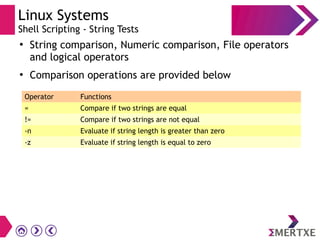
![Linux Systems
Shell Scripting - String Tests
1 #!/bin/bash
2
3 echo “Enter the first string”
4 read STR1
5 echo “Enter the second string”
6 read STR2
7
8 if [ -z ${STR1} ]; then
9 echo "First string is empty"
10 else
11 echo "First string is not empty"
12 fi
13 if [ -n ${STR2} ]; then
14 echo "Second string is not empty"
15 else
16 echo "Second string is empty"
17 fi
18 if [ ${STR1} = ${STR2} ]; then
19 echo "Both strings are equal"
20 else
21 echo "Both strings are not equal"
22 fi
~
"5_string_test.sh" 22L, 405C 0,0-1 All
user@user:PPT-Examples] vi 5_string_test.sh](https://image.slidesharecdn.com/linuxsystems1-190430101433/85/Linux-Systems-Getting-started-with-setting-up-an-Embedded-platform-125-320.jpg)
![Linux Systems
Shell Scripting - String Tests
user@user:PPT-Examples] chmod +x 5_string_test.sh
user@user:PPT-Examples] ./5_string_test.sh
“Enter the first string”
Hello
“Enter the second string”
World
First string is not empty
Second string is not empty
Both strings are not equal
user@user:PPT-Examples] ./5_string_test.sh
“Enter the first string”
Hello
“Enter the second string”
Hello
First string is not empty
Second string is not empty
Both strings are equal
user@user:PPT-Examples]](https://image.slidesharecdn.com/linuxsystems1-190430101433/85/Linux-Systems-Getting-started-with-setting-up-an-Embedded-platform-126-320.jpg)
![Linux Systems
Shell Scripting – Logical Operators
Operator Functions
! Compare if two strings are equal
-a Logically AND two logical expression
-o Logically OR two logical expressions
1 #!/bin/bash
2
3 echo “Enter the first number A” ; read A
4 echo “Enter the second number B” ; read B
5 echo “Enter the third number C” ; read C
6
7 if [ ${A} -gt ${B} -a ${A} -gt ${C} ]; then
8 echo "A is the greatest of all"
9 elif [ ${B} -gt ${A} -a ${B} -gt ${C} ]; then
10 echo "B is the greatest of all"
14 elif [ ${C} -gt ${A} -a ${C} -gt ${B} ]; then
15 echo "C is the greatest of all"
16 else
17 echo "Invalid Input"
18 fi
"6_logical_operators.sh" 18L, 426C 0,0-1 All
user@user:PPT-Examples] vi 6_logical_operator.sh](https://image.slidesharecdn.com/linuxsystems1-190430101433/85/Linux-Systems-Getting-started-with-setting-up-an-Embedded-platform-127-320.jpg)
![Linux Systems
Shell Scripting - Logical Operator
user@user:PPT-Examples] chmod +x 6_logical_operator.sh
user@user:PPT-Examples] ./6_logical_operator.sh
“Enter the first number A”
10
“Enter the second number B ”
2
“Enter the third number C ”
3
A is the greatest of all
user@user:PPT-Examples] ./6_logical_operator.sh
“Enter the first number A”
3
“Enter the second number B ”
10
“Enter the third number C ”
2
B is the greatest of all
user@user:PPT-Examples]](https://image.slidesharecdn.com/linuxsystems1-190430101433/85/Linux-Systems-Getting-started-with-setting-up-an-Embedded-platform-128-320.jpg)

![Linux Systems
File Specific Cmds & Opers - more
●
more helps us to view a file content page wise
user@user:PPT-Examples] more 2_if_then.sh # Use q to quit
#!/bin/bash
NUM1=15
NUM2=6
if [ ${NUM1} -gt ${NUM2} ]
then
echo "NUM1 is greater than NUM2"
else
echo "NUM2 is greater than NUM1"
fi
user@user:PPT-Examples]
●
Note, if the file size if greater than the window size you
would have page view
●
You may try the below example
user@user:PPT-Examples] sudo more /var/log/syslog](https://image.slidesharecdn.com/linuxsystems1-190430101433/85/Linux-Systems-Getting-started-with-setting-up-an-Embedded-platform-130-320.jpg)
![Linux Systems
File Specific Cmds & Opers - less
●
less similar to more with many features
user@user:PPT-Examples] less 2_if_then.sh # Use q to quit
●
Note, if the file size if greater than the window size you
would have page view
●
You may try the below example
user@user:PPT-Examples] sudo less /var/log/syslog
#!/bin/bash
NUM1=15
NUM2=6
if [ ${NUM1} -gt ${NUM2} ]
then
echo "NUM1 is greater than NUM2"
else
echo "NUM2 is greater than NUM1"
fi
2_if_then.sh (END)](https://image.slidesharecdn.com/linuxsystems1-190430101433/85/Linux-Systems-Getting-started-with-setting-up-an-Embedded-platform-131-320.jpg)
![Linux Systems
File Specific Cmds & Opers - | (pipe)
●
A pipe is a form of redirection that is used in Linux
operating systems to send the output of one program to
another program for further processing.
●
A pipe is designated in commands by the vertical bar
character
user@user:PPT-Examples] ls
10_cmd_line_args.sh 4_string_test.sh 8_while_loop.sh
1_expressions.sh 5_logical_operators.sh 9_arrays.sh
2_if_then.sh 6_case_statements.sh
3_if_elif.sh 7_for_loop.sh
user@user:PPT-Examples] ls | wc # Gives the word count info from ls output
10 10 166
user@user:PPT-Examples]
●
It is a very useful operator. Well see some more usage in
later slide](https://image.slidesharecdn.com/linuxsystems1-190430101433/85/Linux-Systems-Getting-started-with-setting-up-an-Embedded-platform-132-320.jpg)
![Linux Systems
File Specific Cmds & Opers - head
●
head helps us to output the first part of files
user@user:PPT-Examples] head -5 1_expressions.sh # Print first 5 lines
#!/bin/bash
NUM1=5
NUM2=3
user@user:PPT-Examples]
user@user:PPT-Examples] ls -1v | head -5 # Print first 5 lines for ls output
1_expressions.sh
2_if_then.sh
3_if_elif.sh
4_string_test.sh
5_logical_operators.sh
user@user:PPT-Examples]](https://image.slidesharecdn.com/linuxsystems1-190430101433/85/Linux-Systems-Getting-started-with-setting-up-an-Embedded-platform-133-320.jpg)
![Linux Systems
File Specific Cmds & Opers - tail
●
tail helps us to output the last part of files
user@user:PPT-Examples] tail -5 1_expressions.sh # Print last 5 lines
echo -e "Addition of two numbers istt: ${ADD}"
echo -e "Substraction of two numbers istt: ${SUB}"
echo -e "Multiplication of two numbers ist: ${MUL}"
echo -e "Division of two numbers istt: ${DIV}"
echo -e "Modulum of two numbers istt: ${MOD}"
user@user:PPT-Examples]
user@user:PPT-Examples] ls -1v | tail -5 # Print first 5 lines for ls output
7_for_loop.sh
7_while_loop.sh
6_case_statements.sh
9_arrays.sh
10_cmd_line_args.sh
user@user:PPT-Examples]](https://image.slidesharecdn.com/linuxsystems1-190430101433/85/Linux-Systems-Getting-started-with-setting-up-an-Embedded-platform-134-320.jpg)

![Linux Systems
File Specific Cmds & Opers - Redirection
user@user:PPT-Examples] ls
10_cmd_line_args.sh 4_string_test.sh 8_while_loop.sh
1_expressions.sh 5_logical_operators.sh 9_arrays.sh
2_if_then.sh 6_case_statements.sh
3_if_elif.sh 7_for_loop.shh
user@user:PPT-Examples] echo Hello > test.txt
user@user:PPT-Examples] ls
10_cmd_line_args.sh 4_string_test.sh 8_while_loop.sh
1_expressions.sh 5_logical_operators.sh 9_arrays.sh
2_if_then.sh 6_case_statements.sh test.txt
3_if_elif.sh 7_for_loop.sh
user@user:PPT-Examples] cat text.txt
Hello
user@user:PPT-Examples] echo World > test.txt # Overwrites the files
user@user:PPT-Examples] cat text.txt
World
user@user:PPT-Examples] echo Hello >> test.txt
user@user:PPT-Examples] cat text.txt
World
Hello
user@user:PPT-Examples]](https://image.slidesharecdn.com/linuxsystems1-190430101433/85/Linux-Systems-Getting-started-with-setting-up-an-Embedded-platform-136-320.jpg)
![Linux Systems
File Specific Cmds & Opers - Redirection
user@user:PPT-Examples] ls
10_cmd_line_args.sh 4_string_test.sh 8_while_loop.sh
1_expressions.sh 5_logical_operators.sh 9_arrays.sh
2_if_then.sh 6_case_statements.sh test.txt
3_if_elif.sh 7_for_loop.sh
user@user:PPT-Examples] ls 9_arrays.sh 1234 > test.txt
ls: cannot access '1234': No such file or directory
user@user:PPT-Examples] cat text.txt
9_arrays.sh
user@user:PPT-Examples] ls 9_arrays.sh 1234 2> test.txt
9_arrays.sh
user@user:PPT-Examples] cat text.txt
ls: cannot access '1234': No such file or directory
user@user:PPT-Examples] echo 1 + 2 > text.txt
user@user:PPT-Examples] bc < test.txt # The file contents is passed as input
3
user@user:PPT-Examples] rm text.txt # Not needed anymore
user@user:PPT-Examples]](https://image.slidesharecdn.com/linuxsystems1-190430101433/85/Linux-Systems-Getting-started-with-setting-up-an-Embedded-platform-137-320.jpg)
![Linux Systems
File Specific Cmds & Opers - du
●
du helps us to estimate file space usage
user@user:PPT-Examples] du
44 .
user@user:PPT-Examples] du -h # Human readable
44K .
user@user:PPT-Examples] du -sb * # Size in bytes
301 10_cmd_line_args.sh
416 1_expressions.sh
139 2_if_then.sh
200 3_if_elif.sh
405 4_string_test.sh
427 5_logical_operators.sh
187 6_case_statements.sh
131 7_for_loop.sh
103 8_while_loop.sh
436 9_arrays.sh
user@user:PPT-Examples]](https://image.slidesharecdn.com/linuxsystems1-190430101433/85/Linux-Systems-Getting-started-with-setting-up-an-Embedded-platform-138-320.jpg)
![Linux Systems
File Specific Cmds & Opers - df
●
df helps us to fine system disk space usage
user@user:PPT-Examples] df
tmpfs 803976 9520 794456 2% /run
/dev/sda1 76765204 9557568 63285052 14% /
tmpfs 4019868 8484 4011384 1% /dev/shm
tmpfs 5120 4 5116 1% /run/lock
tmpfs 4019868 0 4019868 0% /sys/fs/cgroup
/dev/sda6 519987072 71655932 421847532 15% /home
tmpfs 803976 60 803916 1% /run/user/1001
user@user:PPT-Examples] df -h # Human readable
udev 3.9G 0 3.9G 0% /dev
tmpfs 786M 9.3M 776M 2% /run
/dev/sda1 74G 9.2G 61G 14% /
tmpfs 3.9G 8.3M 3.9G 1% /dev/shm
tmpfs 5.0M 4.0K 5.0M 1% /run/lock
/dev/sda6 496G 69G 403G 15% /home
tmpfs 786M 60K 786M 1% /run/user/1001
user@user:PPT-Examples]](https://image.slidesharecdn.com/linuxsystems1-190430101433/85/Linux-Systems-Getting-started-with-setting-up-an-Embedded-platform-139-320.jpg)
![Linux Systems
File Specific Cmds & Opers - df
●
df helps us to find system disk space usage
user@user:PPT-Examples] df # Note the output depends on the installation
tmpfs 803976 9520 794456 2% /run
/dev/sda1 76765204 9557568 63285052 14% /
tmpfs 4019868 8484 4011384 1% /dev/shm
tmpfs 5120 4 5116 1% /run/lock
tmpfs 4019868 0 4019868 0% /sys/fs/cgroup
/dev/sda6 519987072 71655932 421847532 15% /home
tmpfs 803976 60 803916 1% /run/user/1001
user@user:PPT-Examples] df -h # Human readable
udev 3.9G 0 3.9G 0% /dev
tmpfs 786M 9.3M 776M 2% /run
/dev/sda1 74G 9.2G 61G 14% /
tmpfs 3.9G 8.3M 3.9G 1% /dev/shm
tmpfs 5.0M 4.0K 5.0M 1% /run/lock
/dev/sda6 496G 69G 403G 15% /home
tmpfs 786M 60K 786M 1% /run/user/1001
user@user:PPT-Examples]](https://image.slidesharecdn.com/linuxsystems1-190430101433/85/Linux-Systems-Getting-started-with-setting-up-an-Embedded-platform-140-320.jpg)
![Linux Systems
File Specific Cmds & Opers - stat
●
stat helps us to display file or file system status
user@user:PPT-Examples] stat 1_expression.sh
File: '1_expressions.sh'
Size: 416 Blocks: 8 IO Block: 4096 regular file
Device: 806h/2054d Inode: 23600973 Links: 1
Access: (0777/-rwxrwxrwx) Uid: ( 1001/ adil_sk) Gid: ( 1001/ adil_sk)
Access: 2018-12-03 16:24:18.489886098 +0530
Modify: 2018-12-03 14:24:00.896270594 +0530
Change: 2018-12-03 14:29:10.811075929 +0530
Birth: -
user@user:PPT-Examples]](https://image.slidesharecdn.com/linuxsystems1-190430101433/85/Linux-Systems-Getting-started-with-setting-up-an-Embedded-platform-141-320.jpg)
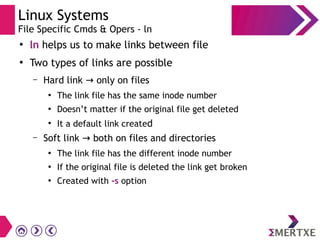
![Linux Systems
File Specific Cmds & Opers – ln – Hard link
user@user:PPT-Examples] echo Hello > test.txt
user@user:PPT-Examples] cat test.txt
Hello
user@user:PPT-Examples] ln test.txt hard_link.txt # Default is hardlink
user@user:PPT-Examples] cat hard_link.txt
Hello
user@user:PPT-Examples] echo World >> hard_link.txt
user@user:PPT-Examples] cat text.txt
Hello
World
user@user:PPT-Examples] stat text.txt | head -3
File: 'text.txt'
Size: 6 Blocks: 8 IO Block: 4096 regular file
Device: 806h/2054d Inode: 23600979 Links: 2
user@user:PPT-Examples] stat hard_link.txt | head -3
File: 'hard_link.txt'
Size: 6 Blocks: 8 IO Block: 4096 regular file
Device: 806h/2054d Inode: 23600979 Links: 2
user@user:PPT-Examples] rm text.txt # Doesn’t effect the hard link!!
user@user:PPT-Examples] cat hard_link.txt
Hello
World
user@user:PPT-Examples]](https://image.slidesharecdn.com/linuxsystems1-190430101433/85/Linux-Systems-Getting-started-with-setting-up-an-Embedded-platform-143-320.jpg)
![Linux Systems
File Specific Cmds & Opers – ln – Soft link
user@user:PPT-Examples] echo Hello > test.txt
user@user:PPT-Examples] ln -s test.txt soft_link.txt
user@user:PPT-Examples] ls -l soft_link.txt
lrwxrwxrwx 1 user user 8 Dec 4 15:01 soft_link.txt -> test.txt
user@user:PPT-Examples] cat soft_link.txt
Hello
user@user:PPT-Examples] echo World >> soft_link.txt
user@user:PPT-Examples] cat text.txt
Hello
World
user@user:PPT-Examples] stat text.txt | head -3
File: 'text.txt'
Size: 6 Blocks: 8 IO Block: 4096 regular file
Device: 806h/2054d Inode: 23601012 Links: 1
user@user:PPT-Examples] stat hard_link.txt | head -3
File: 'soft_link.txt'
Size: 8 Blocks: 8 IO Block: 4096 regular file
Device: 806h/2054d Inode: 23600982 Links: 1
user@user:PPT-Examples] rm text.txt # This effects the soft link!!
user@user:PPT-Examples] cat soft_link.txt
cat: soft_link.txt: No such file or directory
user@user:PPT-Examples] ls -l soft_link.txt # Broken link!!
lrwxrwxrwx 1 user user 8 Dec 4 15:01 soft_link.txt -> test.txt
user@user:PPT-Examples]](https://image.slidesharecdn.com/linuxsystems1-190430101433/85/Linux-Systems-Getting-started-with-setting-up-an-Embedded-platform-144-320.jpg)
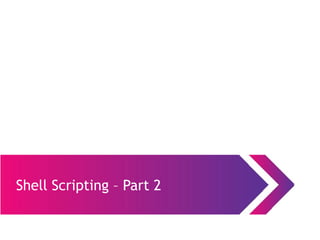

![Linux Systems
Shell Scripting - Loops – for
1 #!/bin/bash
2
3 for i in 1 2 3 4 5
4 do
5 echo "Loop counter is ${i}"
6 done
~
"2_for_loop.sh" 6L, 70C 0,0-1 All
user@user:PPT-Examples] vi 7_for_loop.sh
user@user:PPT-Examples] chmod +x 7_for_loop.sh
user@user:PPT-Examples] ./7_for_loop.sh
Loop counter is 1
Loop counter is 2
Loop counter is 3
Loop counter is 4
Loop counter is 5
user@user:PPT-Examples]](https://image.slidesharecdn.com/linuxsystems1-190430101433/85/Linux-Systems-Getting-started-with-setting-up-an-Embedded-platform-147-320.jpg)
![Linux Systems
Shell Scripting - Loops – while
●
The structure is a looping structure. Used to execute a
set of commands while a specified condition is true
●
The loop terminates as soon as the condition becomes
false. If condition never becomes false, loop will never
exit
●
Any valid conditional expression will work in the while
loop.
while [ condition ]
do
Code Block
done
Syntax](https://image.slidesharecdn.com/linuxsystems1-190430101433/85/Linux-Systems-Getting-started-with-setting-up-an-Embedded-platform-148-320.jpg)
![Linux Systems
Shell Scripting - Loops – for
1 #!/bin/bash
2
3 LOOP=1
4
5 while [ ${LOOP} -le 5 ]
6 do
7 echo "Looping : ${LOOP}"
8 LOOP=$((${LOOP} + 1))
9 done
~
"8_while_loop.sh" 9L, 103C 0,0-1 All
user@user:PPT-Examples] vi 8_while_loop.sh
user@user:PPT-Examples] chmod +x 8_while_loop.sh
user@user:PPT-Examples] ./8_while_loop.sh
Looping : 1
Looping : 2
Looping : 3
Looping : 4
Looping : 5
user@user:PPT-Examples]](https://image.slidesharecdn.com/linuxsystems1-190430101433/85/Linux-Systems-Getting-started-with-setting-up-an-Embedded-platform-149-320.jpg)
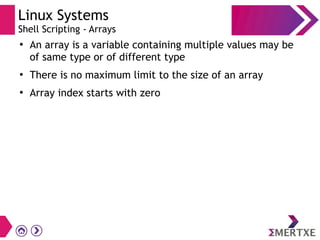
![Linux Systems
Shell Scripting - Arrays
1 #!/bin/bash
2
3 echo "Number of elements in the array: ${#LINUX_DISTROS[@]}"
4 echo "Printing elements of array in one shot: ${LINUX_DISTROS[@]}"
5 echo "Printing elements of array in one shot: ${LINUX_DISTROS[*]}"
6 echo "Printing elements of array in using a loop:"
7 for ((i = 0; i < ${#LINUX_DISTROS[@]}; i++))
8 do
9 echo ${LINUX_DISTROS[$i]}
10 done
~
"9_arrays.sh" 11L, 146C 0,0-1 All
user@user:PPT-Examples] vi 9_arrays.sh
user@user:PPT-Examples] chmod +x 9_arrays.sh
user@user:PPT-Examples] ./9_arrays.sh
Number of elements in the array: 5
Printing elements of array in one shot : Debian Redhat Ubuntu Suse Fedora
Printing elements of array in one shot : Debian Redhat Ubuntu Suse Fedora
Printing elements of array in using a loop : Debian Redhat Ubuntu Suse Fedora
user@user:PPT-Examples]](https://image.slidesharecdn.com/linuxsystems1-190430101433/85/Linux-Systems-Getting-started-with-setting-up-an-Embedded-platform-151-320.jpg)

![Linux Systems
Shell Scripting - Command Line Arguments
1 #!/bin/bash
2
3 if [ $# != 2 ]
4 then
5 echo "Usage: Pass 3 arguments"
6 exit 0
7 fi
8
9 echo "The arguments of the script you passed are:"
10 echo "Total number of arguments you passed are : $#"
11 echo "The name of the script is : $0"
12 echo "The first argument is : $1"
13 echo "The second argument is : $2"
~
"10_cmd_line_args.sh" 13L, 301C 0,0-1 All
user@user:PPT-Examples] vi 10_cmd_line_args.sh](https://image.slidesharecdn.com/linuxsystems1-190430101433/85/Linux-Systems-Getting-started-with-setting-up-an-Embedded-platform-153-320.jpg)
![Linux Systems
Shell Scripting - Command Line Arguments
user@user:PPT-Examples] chmod +x 10_cmd_line_args.sh
user@user:PPT-Examples] ./10_cmd_line_args.sh Hello 1234
The arguments of the script you passed are:
Total number of arguments you passed are : 2
The name of the script is : ./10_cmd_line_args.sh
The first argument is : Hello
The second argument is : 1234
user@user:PPT-Examples]](https://image.slidesharecdn.com/linuxsystems1-190430101433/85/Linux-Systems-Getting-started-with-setting-up-an-Embedded-platform-154-320.jpg)

![Linux Systems
Shell Scripting - Functions
1 #!/bin/bash
2
3 function sum()
4 {
5 x=`expr $1 + $2`
6 echo $x
7 }
8
9 y=`sum 5 3`
10 echo "The sum is 5 and 3 is $y"
11 echo "The sum is 6 and 2 is `sum 6 2`"
~
"11_functions.sh" 11L, 146C 0,0-1 All
user@user:PPT-Examples] vi 11_functions.sh
user@user:PPT-Examples] chmod +x 11_functions.sh
user@user:PPT-Examples] ./11_functions.sh
The sum is 5 and 3 is 8
The sum is 6 and 2 is 8
user@user:PPT-Examples]](https://image.slidesharecdn.com/linuxsystems1-190430101433/85/Linux-Systems-Getting-started-with-setting-up-an-Embedded-platform-156-320.jpg)



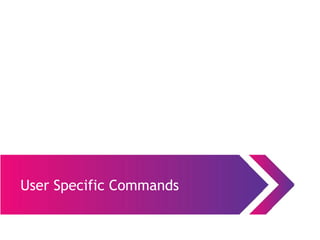
![Linux Systems
User Specific Commands – useradd and su
●
All Accesses into a Linux System are through a User
●
Super user (root) will have higher privileges
●
useradd helps us to create a new user or update default new
user information
user@user:~] useradd pingu
useradd: Permission denied.
useradd: cannot lock /etc/passwd; try again later.
user@user:~] sudo useradd pingu
[sudo] password for user:
user@user:~]
●
su to change user ID or become superuser
user@user:~] su - pingu # Note, we did not set the password yet
Password:
●
We need to set the password!. Refer the next slide](https://image.slidesharecdn.com/linuxsystems1-190430101433/85/Linux-Systems-Getting-started-with-setting-up-an-Embedded-platform-161-320.jpg)
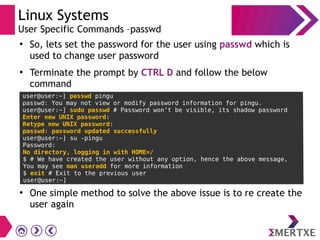

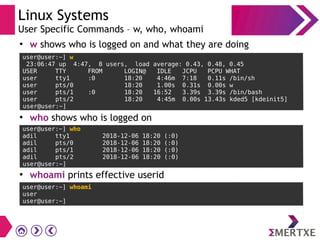
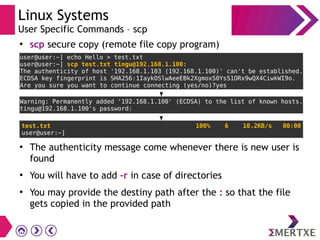

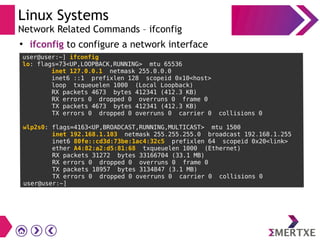


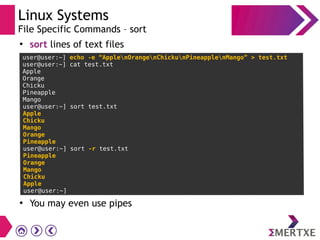

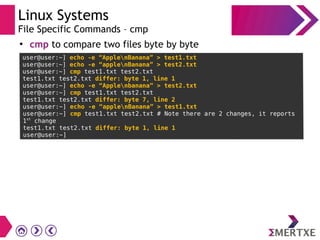



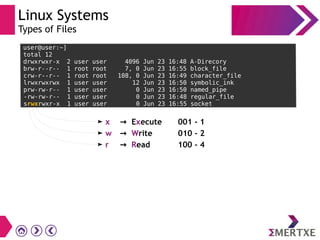
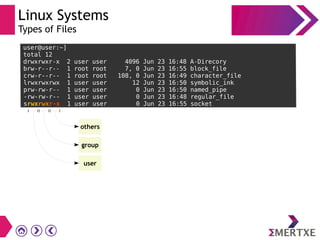
![Linux Systems
File Specific Commands – chmod
●
chmod used to change file mode bits
user@user:~] touch test.txt
user@user:~] ls -l test.txt
-rw-rw-r-- 1 user user 0 Dec 10 18:40 test.txt
user@user:~] chmod 777 test.txt
user@user:~] ls -l test.txt
-rwxrwxrwx 1 user user 0 Dec 10 18:40 test.txt
user@user:~] chmod 707 test.txt
user@user:~] ls -l test.txt
-rwx---rwx 1 user user 0 Dec 10 18:40 test.txt
user@user:~] chmod -x test.txt
user@user:~] ls -l test.txt
-rw-rw-rw- 1 user user 0 Dec 10 18:40 test.txt
user@user:~] chmod o+x test.txt
user@user:~] ls -l test.txt
-rw-rwxrw- 1 user user 0 Dec 10 18:40 test.txt
user@user:~] chmod a-r test.txt
user@user:~] ls -l test.txt
--w--wx-w- 1 user user 0 Dec 10 18:40 test.txt
user@user:~]](https://image.slidesharecdn.com/linuxsystems1-190430101433/85/Linux-Systems-Getting-started-with-setting-up-an-Embedded-platform-178-320.jpg)
![Linux Systems
File Specific Commands – chown
●
chown used to file owner and group
●
user@user:~] ls -l test.txt
-rw-rw-r-- 1 user user 0 Dec 10 18:40 test.txt
user@user:~] sudo chown user.nobody test.txt
user@user:~] ls -l test.txt
-rw-rw-r-- 1 user nobody 0 Dec 10 18:40 test.txt
user@user:~] mkdir TBD # To Be Deleted
user@user:~] touch TBD/{1..4}.txt # Just create 4 files
user@user:~] ls -l TBD
total 0
-rw-rw-r-- 1 user user 0 Dec 10 19:01 1.txt
-rw-rw-r-- 1 user user 0 Dec 10 19:01 2.txt
-rw-rw-r-- 1 user user 0 Dec 10 19:01 3.txt
-rw-rw-r-- 1 user user 0 Dec 10 19:01 4.txt
user@user:~] sudo chown user.nobody -R TBD # Recursive, since directory
user@user:~] ls -l TBD
total 0
-rw-rw-r-- 1 user nobody 0 Dec 10 19:01 1.txt
-rw-rw-r-- 1 user nobody 0 Dec 10 19:01 2.txt
-rw-rw-r-- 1 user nobody 0 Dec 10 19:01 3.txt
-rw-rw-r-- 1 user nobody 0 Dec 10 19:01 4.txt
user@user:~] rm -fr TBD/ test.txt # Just remove the stray contents
user@user:~]](https://image.slidesharecdn.com/linuxsystems1-190430101433/85/Linux-Systems-Getting-started-with-setting-up-an-Embedded-platform-179-320.jpg)

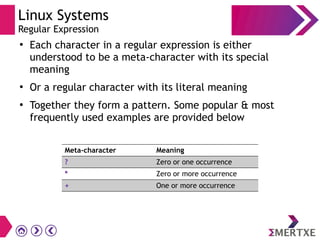
![Linux Systems
Search Commands – find
●
find to search for files in a directory hierarchy
●user@user:~] mkdir -p TBD/Dir1
user@user:~] touch TBD/Dir1/{1..4}.txt
user@user:~] mkdir TBD/Dir2
user@user:~] echo hello > TBD/Dir2/non_empty_file.txt
user@user:~] echo ls > TBD/Dir2/my_ls.sh
user@user:~] chmod +x TBD/Dir2/my_ls.sh
user@user:~] cd TBD
user@user:TBD] find . -print # Prints the contents of current directory
.
./Dir2
./Dir2/non_empty_file.txt
./Dir2/my_ls.sh
./Dir1
./Dir1/1.txt
./Dir1/4.txt
./Dir1/2.txt
./Dir1/3.txt
user@user:TBD] find . -name 1.txt
./Dir1/1.txt
user@user:TBD] find . -name *.sh
./Dir2/my_ls.sh
user@user:TBD]](https://image.slidesharecdn.com/linuxsystems1-190430101433/85/Linux-Systems-Getting-started-with-setting-up-an-Embedded-platform-182-320.jpg)
![Linux Systems
Search Commands – find
user@user:TBD] find . -empty
./Dir1/1.txt
./Dir1/4.txt
./Dir1/2.txt
./Dir1/3.txt
user@user:TBD] find . ! -empty
.
./Dir2
./Dir2/non_empty_file.txt
./Dir2/my_ls.sh
./Dir1
user@user:TBD] find . -type f -executable
./Dir2/my_ls.sh
user@user:TBD] find ../ -type d -name Dir1
../TBD1/Dir1
user@user:TBD]](https://image.slidesharecdn.com/linuxsystems1-190430101433/85/Linux-Systems-Getting-started-with-setting-up-an-Embedded-platform-183-320.jpg)
![Linux Systems
Search Commands – grep
●
grep to print lines matching a pattern
●
Get Regular Expression And Print (GREP)
●
Is a pattern matching tool used to search the name input file
user@user:TBD] echo -e “ApplenGrapesnBanana” > Dir1/1.txt
user@user:TBD] echo -e “Raw BanananCarrotnTomato” > Dir1/2.txt
user@user:TBD] echo -e “BanglesnCardnToothpick” > Dir1/3.txt
user@user:TBD] grep Apple Dir1/1.txt
Apple
user@user:TBD] grep -r Apple . # Search Apple at the given path.
Dir1/1.txt:Apple
user@user:TBD] grep -r Ban # Default path is current diretory
Dir1/1.txt:Banana
Dir1/2.txt:Raw Banana#
Dir1/3.txt:Bangles
user@user:TBD] grep -r Banana
Dir1/1.txt:Banana
Dir1/2.txt:Raw Banana
user@user:TBD] grep -rx Banana # Match only the given pattern
Dir1/1.txt:Banana
user@user:TBD]](https://image.slidesharecdn.com/linuxsystems1-190430101433/85/Linux-Systems-Getting-started-with-setting-up-an-Embedded-platform-184-320.jpg)
![Linux Systems
Search Commands – grep
user@user:TBD] grep -rv Ban # Search everything except Ban
Dir2/non_empty_file.txt:hello
Dir2/my_ls.sh:ls
Dir1/1.txt:Apple
Dir1/1.txt:Grapes
Dir1/2.txt:Carrot
Dir1/2.txt:Tomato
Dir1/3.txt:Bangles
Dir1/3.txt:Card
Dir1/3.txt:Toothpick
user@user:TBD] grep -r Car
Dir1/3.txt:Card
user@user:TBD] grep -ri Car # Ignore case
Dir1/2.txt:carrot
Dir1/3.txt:Card
user@user:TBD] grep -rin Ban # Show line numbers
Dir1/1.txt:3:Banana
Dir1/2.txt:1:Raw Banana
Dir1/3.txt:1:Bangles
user@user:TBD]](https://image.slidesharecdn.com/linuxsystems1-190430101433/85/Linux-Systems-Getting-started-with-setting-up-an-Embedded-platform-185-320.jpg)
![Linux Systems
Substitute Command – sed
●
sed is a stream editor for filtering and transforming text
●
It can be a file, or input from a pipe
user@user:TBD] sed ‘s/Apple/apple/’ Dir1/1.txt # Doesn’t change in file!
apple
Grapes
Banana
user@user:TBD] cat Dir1/1.txt
Apple
Grapes
Banana
user@user:TBD] sed -i ‘s/Apple/apple/’ Dir1/1.txt # Saves into the file
user@user:TBD] cat Dir1/1.txt
apple
Grapes
Banana
user@user:TBD] sed '3s/a/A/' Dir1/1.txt
apple
Grapes
BAnana
user@user:TBD]](https://image.slidesharecdn.com/linuxsystems1-190430101433/85/Linux-Systems-Getting-started-with-setting-up-an-Embedded-platform-186-320.jpg)
![Linux Systems
Substitute Command – sed
user@user:TBD] sed '3s/a/A/g' Dir1/1.txt # Change globally
apple
Grapes
BAnAnA
user@user:TBD] echo -e “MangonPineapple” >> Dir1/1.txt
user@user:TBD] cat Dir1/1.txt
Apple
Grapes
Banana
Mango
Pineapple
user@user:TBD] sed -n ‘2,4p’ Dir1/1.txt
Grapes
Banana
Mango
user@user:TBD] sed ‘2,4d’ Dir1/1.txt
Apple
Pineapple
user@user:TBD]](https://image.slidesharecdn.com/linuxsystems1-190430101433/85/Linux-Systems-Getting-started-with-setting-up-an-Embedded-platform-187-320.jpg)
![Linux Systems
Substitute Command – cut
●
cut is used to remove sections from each line of files
user@user:TBD] cat > database.txt # Use CTRL-D to end
Tingu, 9783422342, tingu@gmail.com
Pingu, 9744527342, pingu@gmail.com
Zingu, 9993234455, zingu@gmail.com
user@user:TBD] cat database.txt
Tingu, 9783422342, tingu@gmail.com
Pingu, 9744527342, pingu@gmail.com
Zingu, 9993234455, zingu@gmail.com
user@user:TBD] cut -d"," -f1 database.txt # Cut 1st
field
Tingu
Pingu
Zingu
user@user:TBD] cut -d"," -f2,3 database.txt # Cut 2nd
and 3rd
field
9783422342, tingu@gmail.com
9744527342, pingu@gmail.com
9993234455, zingu@gmail.com
user@user:TBD] cut -c5 database.txt # Cut 5th
character
u
u
u
user@user:TBD]](https://image.slidesharecdn.com/linuxsystems1-190430101433/85/Linux-Systems-Getting-started-with-setting-up-an-Embedded-platform-188-320.jpg)
![Linux Systems
Substitute Command – cut
●
Many more interesting combinations are possible
●
You use the piped outputs to cut
user@user:TBD] cut -c5 --complement database.txt # Get all except 5th
char
Ting, 9783422342, tingu@gmail.com
Ping, 9744527342, pingu@gmail.com
Zing, 9993234455, zingu@gmail.com
user@user:TBD] cut -c8-11 database.txt # Get a range from 8th
to 11th
chars
9783
9744
9993
user@user:TBD]
user@user:TBD] dmesg | tail -5 | cut -c1-15 # Get only the kernel time stamp
[ 1378.145670]
[ 1378.145685]
[ 1378.145695]
[ 1378.145935]
[ 1378.145952]
user@user:TBD]](https://image.slidesharecdn.com/linuxsystems1-190430101433/85/Linux-Systems-Getting-started-with-setting-up-an-Embedded-platform-189-320.jpg)
![Linux Systems
Substitute Command – split
●
split is used to split a file into pieces
user@user:TBD] mkdir TBD # Just to collect all the splited files
user@user:TBD] cat database.txt
Tingu, 9783422342, tingu@gmail.com
Pingu, 9744527342, pingu@gmail.com
Zingu, 9993234455, zingu@gmail.com
user@user:TBD] split database.txt TBD/ # Split into files
user@user:TBD] ls TBD
aa
user@user:TBD] split -1 database.txt TBD/ # Split every line into a file
user@user:TBD] ls TBD
aa ab ac
user@user:TBD] cat TBD/aa
Tingu, 9783422342, tingu@gmail.com
user@user:TBD] cat TBD/ac
Zingu, 9993234455, zingu@gmail.com
user@user:TBD] split -b5 database.txt T1BD # Split every 5 bytes into a file
user@user:TBD] ls TBD
aa ab ac ad ae af ag ah ai aj ak al am an ao ap aq ar as
at au
user@user:TBD] cat TBD/aa # Has 5 bytes from 1st
line
Tinguuser@user:TBD] cat TBD/ab # Has next 5 bytes from 1st
line and it goes on
, 978user@user:TBD]](https://image.slidesharecdn.com/linuxsystems1-190430101433/85/Linux-Systems-Getting-started-with-setting-up-an-Embedded-platform-190-320.jpg)
![Linux Systems
Substitute Command – tr
●
tr translates or deletes characters
user@user:TBD] echo hello how are you | tr -d h # Delete all ‘h’
ello ow are you
user@user:TBD] echo hello how are you | tr [:space:] t
Hello how are you
user@user:TBD] echo "my age is 99" | tr -d [:digit:]
my age is
user@user:TBD] tr abcdefghijklmnopqrstuvwxyz ABCDEFGHIJKLMNOPQRSTUVWXYZ
Hello
HELLO
user@user:TBD] tr ABCDEFGHIJKLMNOPQRSTUVWXYZ abcdefghijklmnopqrstuvwxyz
Hello
hello
user@user:TBD] echo "Heelllooo" | tr -s elo
Helo
user@user:TBD]](https://image.slidesharecdn.com/linuxsystems1-190430101433/85/Linux-Systems-Getting-started-with-setting-up-an-Embedded-platform-191-320.jpg)
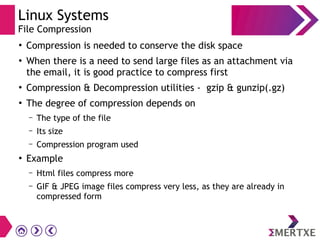
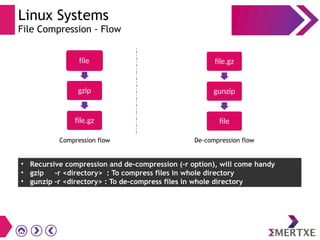
![Linux Systems
File Compression – gzip and gunzip
user@user:TBD] ls
Dir1 Dir2
user@user:TBD] ls Dir1
1.txt 2.txt 3.txt 4.txt
user@user:TBD] gzip Dir1/1.txt # Compress the file
user@user:TBD] ls Dir1
1.txt.gz 2.txt 3.txt 4.txt
user@user:TBD] gunzip Dir1/1.txt.gz # Decompress the file
1.txt 2.txt 3.txt 4.txt
user@user:TBD] gzip -r Dir1
1.txt.gz 2.txt.gz 3.txt.gz 4.txt.gz
user@user:TBD] gunzip -r Dir1/ # Decompress the file
1.txt 2.txt 3.txt 4.txt
user@user:TBD]](https://image.slidesharecdn.com/linuxsystems1-190430101433/85/Linux-Systems-Getting-started-with-setting-up-an-Embedded-platform-194-320.jpg)

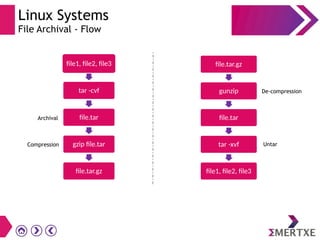
![Linux Systems
File Archival – tar
user@user:TBD] ls
Dir1 Dir2
user@user:TBD] ls Dir1
1.txt 2.txt 3.txt 4.txt
user@user:TBD] tar cvf dir1.tar Dir1/ # Archive Dir1 as dir1.tar
Dir1/
Dir1/1.txt
Dir1/4.txt
Dir1/2.txt
Dir1/3.txt
user@user:TBD] ls
Dir1 dir1.tar Dir2
user@user:TBD] rm -fr Dir1
user@user:TBD] ls
dir1.tar Dir2
user@user:TBD] tar xvf dir1.tar
Dir1/
Dir1/1.txt
Dir1/4.txt
Dir1/2.txt
Dir1/3.tx
user@user:TBD] ls
Dir1 dir1.tar Dir2
user@user:TBD]](https://image.slidesharecdn.com/linuxsystems1-190430101433/85/Linux-Systems-Getting-started-with-setting-up-an-Embedded-platform-197-320.jpg)

